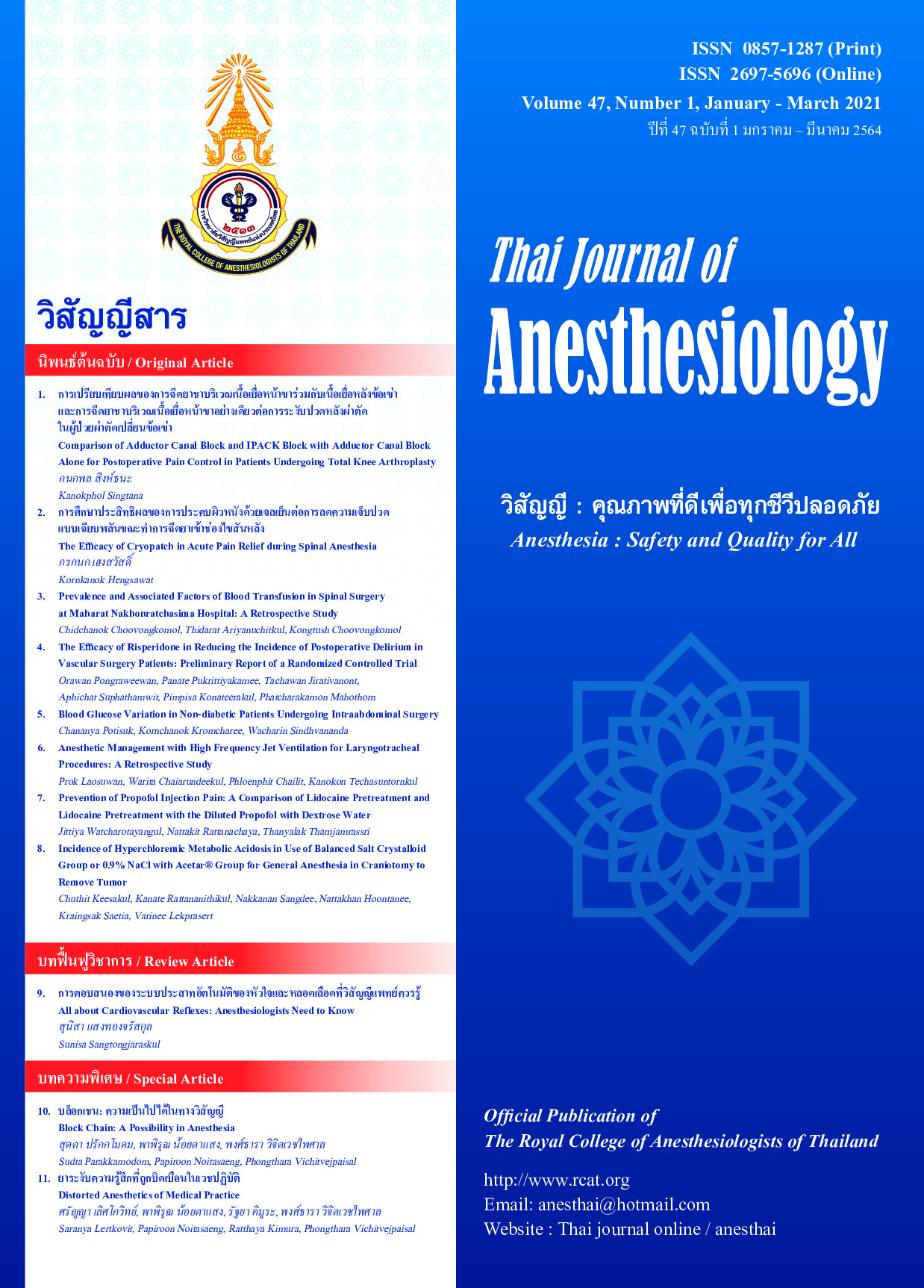Prevalence and Associated Factors of Blood Transfusion in Spinal Surgery at Maharat Nakhonratchasima Hospital: A Retrospective Study
Main Article Content
Abstract
Background: Spine surgery is a high rate of blood
transfusion. This is costly and may have many adverse
effects. Previous studies showed multiple factors
associated with blood transfusion but in our institute, there
is no exact data. Our study is designed to identify
prevalence and associated factors of blood transfusion.
Methods: A retrospective study was designed to identify
all patients undergone spine surgery between 1st February
2019 to 31st January 2020. Demographic data including
amount of blood component given, age, gender, ASA
physical status, BMI, underlying disease, preoperative
hemoglobin, diagnosis and the details of surgery, operative
time and intraoperative blood loss were collected.
Primary outcome was a prevalence of blood transfusion
and secondary outcome was the associated factors of
this transfusion.
Results: Five hundred and sixty-five patients were
included. One hundred and three patients required packed red cell (PRC) transfusion and sixteen patients
required fresh frozen plasma (FFP). Mean PRC and FFP
transfusion are 447.63 and 442.81 ml. One patient needs
10 units of platelet transfusion. Factors associated with
blood transfusion were pulmonary disease (p-value=0.01,
OR=3.60), low preoperative hemoglobin (10-13 g/dl;
p-value <0.001, OR=4.51, < 10 g/dl; p-value=0.01,
OR=8.06), > 3 levels of surgical segments (p-value=0.001,
OR=3.75), posterior approach (p-value=0.01, OR=5.13)
and operative time >120 minutes (p-value<0.001,
OR=19.26).
Conclusions: Prevalence of blood transfusion is 22%
that is considered high and the need for transfusion is
associated with multiple factors. Health care providers
should be aware and well-prepared these cases vigilantly
in order to optimize patient management.
Article Details
References
infectious risks of blood transfusions. JAMA 2003;289:
959-62.
2. Spahn DR, Casutt M. Eliminating blood transfusions: new
aspects and perspectives. Anesthesiology 2000;93:242-55.
3. Berenholtz SM, Pronovost PJ, Mullany D, et al. Predictors of
transfusion for spinal surgery in Maryland, 1997 to 2000.
Transfusion 2002;42:183-9.
4. Butler JS, Burke JP, Dolan RT, et al. Risk analysis of blood
transfusion requirements in emergency and elective spinal
surgery. Eur Spine J 2011;20:753-8.
5. Nuttall GA, Horlocker TT, Santrach PJ, Oliver WC, Jr.,
Dekutoski MB, Bryant S. Predictors of blood transfusions in
spinal instrumentation and fusion surgery. Spine 2000;
25:596-601.
6. Guidelines on non-cardiac surgery: cardiovascular
assessment and management: The joint task force of the
European Society of Cardiology (ESC) and the European
Society of Anaesthesiology (ESA). Eur Heart J 2014;35,
2383-431.
7. Arias-Morales CE, Stoicea N, Gonzalez-Zacarias AA, et al.
Revisiting blood transfusion and predictors of outcome in
cardiac surgery patients: a concise perspective. F1000Res
2017. doi: 10.12688/f1000research.10085.1.
8. Bolliger DA, Gorlinger KL, Tanaka KE. Pathophysiology and
treatment of coagulopathy in massive hemorrhage and
hemodilution. Anesthesiology 2010;113:1205-19.
9. Nuttall GA, Santrach PJ, Oliver WC, Jr, et al. The predictors
of red cell transfusions in total hip arthroplasties: Transfusion
1996;36:144-9.
10. Kahmann RD, Donohue JM, Bradford DS, White JG, Rao GH.
Platelets function in adolescent idiopathic scoliosis. Spine
1992;17:145-8.
11. Surgenor DM, Churchill WH, Wallace EL, et al. Determinants
of red cell, platelet, plasma, and cryoprecipitate transfusions
during coronary artery bypass graft surgery: The
collaborative hospital transfusion study. Transfusion 1996;
36: 521-32.
12. BostmanO, HyrkasJ, HirvensaloE, KallioE. Blood loss,
operating time, and positioning of the patient in lumbar disc
surgery. Spine 1990;15:360-3.
13. Guay J, Haig M, Lortie L, Guertin MC, Poitras B. Predicting
blood loss in surgery for idiopathic scoliosis. Can J Anaesth
1994;41:775-81.
14. Zheng F, Cammisa FP, Jr., Sandhu HS, Girardi FP, Khan SN.
Factors predicting hospital stay, operative time, blood loss,
and transfusion in patients undergoing revision posterior
lumbar spine decompression, fusion, and segmental
instrumentation. Spine 2002;27:818-24.


